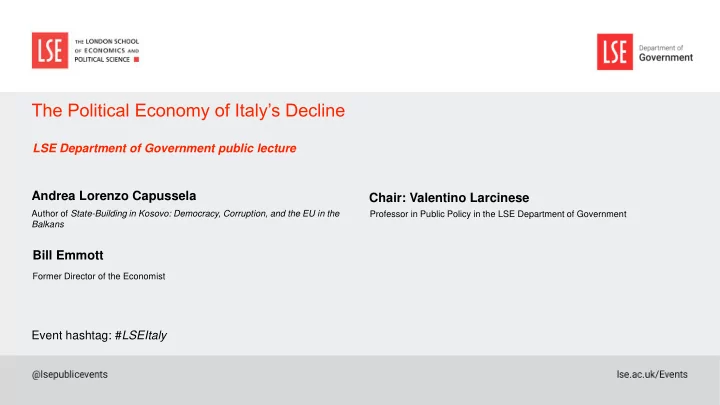

The Political Economy of Italy’s Decline LSE Department of Government public lecture Andrea Lorenzo Capussela Chair: Valentino Larcinese Author of State-Building in Kosovo: Democracy, Corruption, and the EU in the Professor in Public Policy in the LSE Department of Government Balkans Bill Emmott Former Director of the Economist Event hashtag: # LSEItaly
TFP 1950 – 2014 (US=1)
TFP 1980 – 2014 (1980=1)
Contributions to growth 1950 – 2014
A fairly reliable analysis Wide consensus on proximate causes: • small average firm size, low propensity to grow and innovate, comparatively few large firms; • poor public services (e.g., justice, education); • resource misallocation, low ICT diffusion, poor management practices, ‘low -skills trap ’ . So, the four large post-1990 shocks (globalisation, ICT revolution, China/India, EMU) shocks were less opportunities for growth than ‘fetters’ to it.
Some data: TFP and misallocation ‘[I]f in 2013 misallocation had remained at its 1995 level … productivity would have been 18% higher in manufacturing [and] 67% higher in services’ . Calligaris et al. (2016, 32) They also find that misallocation: • is due far more to its within component than to its between component (sector, size, geo); • grew esp. in North-West and among large firms. Moreover, misallocation grew despite rising product market competition (thanks to single market, € ).
Intermediate causes: institutions That analysis suggests that Italy’s transition from a catch-up growth model to one based more on frontier/endogenous innovation was incomplete. This suggests that institutions (North: ‘rules of the game’) are the main intermediate causes, as they: • determine the efficiency of product and factor markets; • more generally, they shape the incentives to invest and innovate.
Rule of Law 1996 – 2015 (WGI)
Control of Corruption 1996 – 2015(WGI)
Minority sh. protection 2008 – 16 (GCR)
Accounting & rep. standards 2008 – 16 (GCR)
Institutional explanation: questions Italy’s institutional problems are old: why would they have become a binding constraint circa 1980 (or 1990)? ‘Appropriate’ institutions (Gerschenkron, Aghion): the synchrony between approach to frontier, evolution of growth model, and institutional reform was broken. After 1990 many ‘good’ institutional reforms were made: why did they not work? Social order (North), or the allocation of power: reforms were distorted, undermined by its logic.
Deeper causes: Italy’s equilibrium Why was that synchrony broken? Why does a democracy not overcome this problem? Multiple equilibria: for ordinary citizens and firms those dilemmas are assurance games, not PDs. Several consistent vicious circles: a spiral. So, multiple collective action problems, exacerbated by the coherence of the politico- economic equilibrium (power, institutions, norms, trust, culture).
Again: TFP 1950 – 2014 (US=1)
One pillar of Italy’s equilibrium The spirit of a people, its cultural level, its social structure, the deeds its policy may prepare — all this and more is written in its fiscal history, stripped of all phrases. Joseph Schumpeter, 1918 Monetary- or debt-financed fiscal expansion: • contributed to off-setting the decline of TFP growth; • financed policy of selective inclusion, which aligned the interests of segments of society with the elites’ .
Again: contr. to growth 1950 – 2014
Debt-to-GDP ratios 1964 – 92
A battle of ideas? Italy’s equilibrium is internally consistent and self- reinforcing, but might be near the limit of its sustainability (e.g. erosion of selective inclusion). Ideas are part of the equilibrium. But they are freer from its grip, and they: • ‘trump’ interests, in the long run (Rodrik 2014); • can change fast: ‘ rebound effect ’ (Hirschman 1982). So, a discussion along these lines: ‘What kind of a society are we? What kind do we want to be?’
Recommend
More recommend